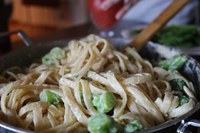Prairie Fare: Are You Thankful for Leftovers?
(Click an image below to view a high-resolution image that can be downloaded)
By Julie Garden-Robinson, Food and Nutrition Specialist
NDSU Extension
We have entered the season associated with leftovers from large holiday meals.
Who likes leftovers, anyway? Some people love leftovers, and some people do not.
I eat food from the previous evening’s meal almost every day. I often eat lunch with someone who does not like leftovers. I’m fairly sure I could use the term “detests” when leftovers are involved.
My usual lunch of leftovers probably nauseates this person.
We all have different relationships with foods, and leftovers may conjure up some memories.
Perhaps you grew up eating leftovers too often, and you decided that once you earned your own money, you would eat “fresh food” every day. Maybe you don’t like the flavor that can result from reheating certain foods.
On the other hand, perhaps you really like food flavors that have had the chance to meld in the refrigerator. I find that spaghetti sauce tastes better the second time.
Leftovers also give us the chance to “skip cooking” because they are ready to eat cold or heat and eat. For me, eating leftovers saves money and reduces food waste, so we usually plan our meals to have some leftovers.
Sensory scientists call the flavor that can develop in certain foods WOF. That’s short for “warmed over flavor” and it usually affects certain types of meat that have been refrigerated a couple of days.
As fat in meat oxidizes, some meats can develop the distinctive “leftover” flavor. However, if you take some steps, you can reduce the development of the flavor.
For example, to reduce the likelihood of flavor changes with storage, you can cover leftover meat with gravy or sauces. Be sure to cover leftovers tightly to exclude light and prevent the food from drying out. For longer-term storage, you can vacuum pack food before freezing it.
Other researchers have found that including herbs and spices, such as rosemary, thyme and sage, can help prevent oxidative changes. Spices are high in natural antioxidants, which help prevent oxidation.
I think our ancestors figured out that spices helped preserve the flavor of foods. You probably have noticed all the thyme and sage included in the main courses served at holiday meals.
If you are cooking for groups this holiday season, keep food safety in mind when serving right away or later. Be sure to cook foods to the safe internal temperature. Cook turkey and other poultry to an internal temperature of at least 165 F. Cool leftover food in shallow pans; metal pans chill food more rapidly than pans made from other materials.
If you know you are not going to be able to use the refrigerated leftovers within three to four days, freeze immediately in meal-sized amounts. Be sure to use appropriate freezer containers and label with the contents and date. Keep an inventory of food that’s in your freezer so you do not forget that it’s there.
If the idea of leftovers is not appetizing, create something completely new. Think of the remaining food as “planned-overs.” How about using leftover turkey in soup, stir-fry, casseroles or sandwiches? Extra mashed potatoes can become potato soup.
Learn to create your own casserole or soup with the “Pinchin’ Pennies in the Kitchen” handouts at https://www.ag.ndsu.edu/food. Click on “Food Preparation.” Also click on “The Family Table” for dozens of ways to savor family mealtimes during the holidays and any day.
Turkey and Broccoli Alfredo
8 ounces fettuccine noodles
2 c. fresh broccoli florets
1/2 medium onion, chopped
1 c. sliced fresh mushrooms
2 tsp. olive or canola oil
2 c. roasted turkey or chicken, cut in strips
1/4 tsp. salt (or to taste)
1/4 tsp. pepper
1 (10.75-ounce) can condensed cream of mushroom soup, reduced sodium
1/2 c. skim milk
1/2 c. shredded Parmesan cheese
Cook fettuccine according to directions, adding the broccoli during the last five minutes of cooking. In a large nonstick skillet, saute onion and mushrooms in oil. Add roasted turkey. Remove from heat; set aside. Drain fettuccine-broccoli mixture, then return to pan. Stir in the soup, milk and turkey mixture. Cook and stir over low heat until heated through. Sprinkle with cheese and serve.
Makes six servings. Each serving has 310 calories, 7 grams (g) fat, 24 g protein, 36 g carbohydrate, 2 g fiber and 510 milligrams sodium.
(Julie Garden-Robinson, Ph.D., R.D., L.R.D., is a North Dakota State University Extension food and nutrition specialist and professor in the Department of Health, Nutrition and Exercise Sciences. Follow her on Twitter @jgardenrobinson)
NDSU Agriculture Communication - Nov. 15, 2018
| Source: | Julie Garden-Robinson, 701-231-7187, julie.garden-robinson@ndsu.edu |
|---|---|
| Editor: | Ellen Crawford, 701-231-5391, ellen.crawford@ndsu.edu |



